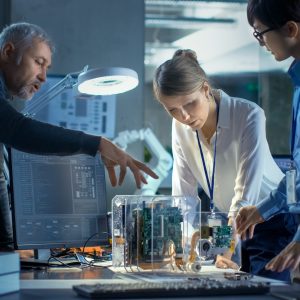
All the digital transformation in the world is not going to get you far without a workforce that can keep up. Businesses must anticipate and prepare for future skills and new technology so they will have a workforce at the ready to seize new opportunities. The problem with getting set for this future? It’s already here, today, and companies must move quickly—using digital tools like AI, augmented reality, microlearning, wearables and IIoT feedback—to upskill their employees with the training they need to thrive in the digital enterprise.
The US has historically been a laggard in manufacturing training—if it wasn’t, there wouldn’t be hundreds of thousands of jobs going begging for lack of worker skills. Countless programs have been launched in the past decade, by both the private sector and government, to catch up with what is both a corporate and national challenge to staff an advanced manufacturing base.
All the usual suspects have been rolled out: individual company apprenticeships; link ups between manufacturing firms and community colleges to establish relevant curricula; efforts to spread the word about manufacturing in secondary education, which has focused students on college futures; and national partnerships and consortia like Manufacturing USA and its Digital Manufacturing and Design Institute (now called MxD), which has a strong education and workforce training component delivered via online courses and “Digital Days” for students.

These are all making a difference, but as always, much of the cutting-edge worker training and upskill innovation is taking place within private firms, as their survival depends upon it. For example, augmented reality is finally going beyond its early hype to establish a foothold in this area, allowing users to “layer” instructional images on top of physical assets to learn.
Microlearning is also growing. Rather than take workers off the plant floor for classroom sessions, online microlearning lets them call up snippets of training as needed during daily tasks. The Industrial Internet of Things even fills a training hole, transmitting streams of data that the digital workforce can use for decision-making and AI-powered execution.
This IIoT “data assist” is one example of the most exciting innovation in modern workforce training: the use of “cognitive assistants” that leverage AI and machine intelligence to fill the knowledge gaps in the workforce. These digital helpers can be embedded in augmented reality systems; for example, delivered via wearables like eye-tracking eyeglasses that record the gazes of high-performance workers to capture best practices for wider organizational dissemination.
This is the “benign” integration of human and machine—not AI taking over the world for malevolent intent, but functioning instead as supportive, value-added “super servants” to enhance human capabilities and increase productivity and innovation.
The result is workforce development that works. It doesn’t depend upon carving out non-value-added time for training and hoping it’s remembered, but rather, by marshaling a cadre of on-call digital help, so the workforce can keep pace with the constant innovation and upskilling required for digital manufacturing.

